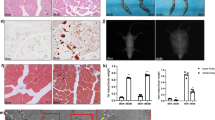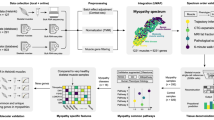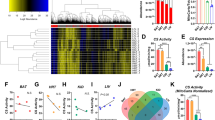Abstract
Mitochondrial research has influenced our understanding of human evolution, physiology and pathophysiology. Mitochondria, intracellular organelles widely known as ‘energy factories’ of the cell, also play fundamental roles in intermediary metabolism, steroid hormone and heme biosyntheses, calcium signaling, generation of radical oxygen species, and apoptosis. Mitochondria possess a distinct DNA (mitochondrial DNA); yet, the vast majority of mitochondrial proteins are encoded by the nuclear DNA. Mitochondria-related genetic defects have been described in a variety of mostly rare, often fatal, primary mitochondrial disorders; furthermore, they are increasingly reported in association with many common morbid conditions, such as cancer, obesity, diabetes and neurodegenerative disorders, although their role remains unclear. This study describes the creation of a human mitochondria-focused cDNA microarray (hMitChip) and its validation in human skeletal muscle cells treated with glucocorticoids. We suggest that hMitChip is a reliable and novel tool that will prove useful for systematically studying the contribution of mitochondrial genomics to human health and disease.
This is a preview of subscription content, access via your institution
Access options
Subscribe to this journal
Receive 6 print issues and online access
$259.00 per year
only $43.17 per issue
Buy this article
- Purchase on Springer Link
- Instant access to full article PDF
Prices may be subject to local taxes which are calculated during checkout



Similar content being viewed by others
Abbreviations
- ACADL:
-
acyl-Coenzyme A dehydrogenase, long chain
- ACADM:
-
acyl-Coenzyme A dehydrogenase, C-4 to C-12 straight chain
- ACADVL:
-
acyl-Coenzyme A dehydrogenase, very long chain
- AK1:
-
adenylate kinase 1
- Dex:
-
dexamethasone
- FACL2:
-
acyl-CoA synthetase long-chain family member 1
- FDX1:
-
ferredoxin 1
- hMitChip:
-
human mitochondria-focused cDNA microarray
- MAOA:
-
monoamine oxidase A
- mtDNA:
-
mitochondrial DNA
- nDNA:
-
nuclear DNA
- PPIB:
-
peptidylprolyl isomerase B (cyclophilin B)
- QRT-PCR:
-
quantitative real-time polymerase chain reaction
- ROS:
-
radical oxygen species.
References
Margulis L . Archaeal-eubacterial mergers in the origin of Eukarya: phylogenetic classification of life. Proc Natl Acad Sci USA 1996; 93: 1071–1076.
Scheffler IE . A century of mitochondrial research: achievements and perspectives. Mitochondrion 2001; 1: 3.
Chinnery PF . Searching for nuclear-mitochondrial genes. Trends Genet 2003; 19: 60–62.
Shoubridge EA . Nuclear genetic defects of oxidative phosphorylation. Hum Mol Genet 2001; 10: 2277–2284.
Van Goethem G, Dermaut B, Lofgren A, Martin JJ, Van Broeckhoven C . Mutation of POLG is associated with progressive external ophthalmoplegia characterized by mtDNA deletions. Nat Genet 2001; 28: 211–212.
Larsson NG, Wang J, Wilhelmsson H, Oldfors A, Rustin P, Lewandoski M et al. Mitochondrial transcription factor A is necessary for mtDNA maintenance and embryogenesis in mice. Nat Genet 1998; 18: 231–236.
Falkenberg M, Gaspari M, Rantanen A, Trifunovic A, Larsson NG, Gustafsson CM . Mitochondrial transcription factors B1 and B2 activate transcription of human mtDNA. Nat Genet 2002; 31: 289–294.
Zeviani M, Corona P, Nijtmans L, Tiranti V . Nuclear gene defects in mitochondrial disorders. Ital J Neurol Sci 1999; 20: 401–408.
Leonard JV, Schapira AH . Mitochondrial respiratory chain disorders II: neurodegenerative disorders and nuclear gene defects. Lancet 2000; 355: 389–394.
Schapira AH . Mitochondrial dysfunction in neurodegenerative disorders. Biochim Biophys Acta 1998; 1366: 225–233.
Kelley DE, He J, Menshikova EV, Ritov VB . Dysfunction of mitochondria in human skeletal muscle in type 2 diabetes. Diabetes 2002; 51: 2944–2950.
Enns GM . The contribution of mitochondria to common disorders. Mol Genet Metab 2003; 80: 11–26.
Osiewacz HD . Mitochondrial functions and aging. Gene 2002; 286: 65–71.
Szewczyk A, Wojtczak L . Mitochondria as a pharmacological target. Pharmacol Rev 2002; 54: 101–127.
Lindal S, Lund I, Torbergsen T, Aasly J, Mellgren SI, Borud O et al. Mitochondrial diseases and myopathies: a series of muscle biopsy specimens with ultrastructural changes in the mitochondria. Ultrastruct Pathol 1992; 16: 263–275.
Khaleeli AA, Edwards RH, Gohil K, McPhail G, Rennie MJ, Round J et al. Corticosteroid myopathy: a clinical and pathological study. Clin Endocrinol (Oxford) 1983; 18: 155–166.
Kayali AG, Young VR, Goodman MN . Sensitivity of myofibrillar proteins to glucocorticoid-induced muscle proteolysis. Am J Physiol 1987; 252: E621–E626.
Hasselgren PO . Glucocorticoids and muscle catabolism. Curr Opin Clin Nutr Metab Care 1999; 2: 201–205.
Mayer M, Chaouat M, Lernau OZ, Nissan S . Hormone-responsive myofibrillar protease activity in cultured rat myoblasts. FEBS Lett 1983; 161: 239–242.
Isozaki U, Mitch WE, England BK, Price SR . Protein degradation and increased mRNAs encoding proteins of the ubiquitin-proteasome proteolytic pathway in BC3H1 myocytes require an interaction between glucocorticoids and acidification. Proc Natl Acad Sci USA 1996; 93: 1967–1971.
Thompson MG, Thom A, Partridge K, Garden K, Campbell GP, Calder G et al. Stimulation of myofibrillar protein degradation and expression of mRNA encoding the ubiquitin-proteasome system in C(2)C(12) myotubes by dexamethasone: effect of the proteasome inhibitor MG-132. J Cell Physiol 1999; 181: 455–461.
Vignos Jr PJ, Greene R . Oxidative respiration of skeletal muscle in experimental corticosteroid myopathy. J Lab Clin Med 1973; 81: 365–378.
Marolda M, Palma V, Camporeale FS, Carandente M, Cioffi M, Orsini AV et al. Steroid myopathy: clinical and immunohistochemical study of a case. Ital J Neurol Sci 1991; 12: 409–413.
Marone JR, Falduto MT, Essig DA, Hickson RC . Effects of glucocorticoids and endurance training on cytochrome oxidase expression in skeletal muscle. J Appl Physiol 1994; 77: 1685–1690.
Duclos M, Gouarne C, Martin C, Rocher C, Mormede P, Letellier T . Effects of corticosterone on muscle mitochondria identifying different sensitivity to glucocorticoids in Lewis and Fischer rats. Am J Physiol Endocrinol Metab 2004; 286: E159–E167.
Alesci S, Su YA, Chrousos GP . hMiDas and hMitChip: New Opportunities in Mitochondrial Bioinformatics and Genomic Medicine. In: Long RAS, Lee DJ, Nutter B, Zhang M (eds.), Seventeenth IEEE Symposium on Computer-Based Medical Systems. IEEE Computer Society Press: Los Alamitos, CA, 2004, pp 329–334.
Goldsmith ZG, Dhanasekaran N . The microrevolution: applications and impacts of microarray technology on molecular biology and medicine (review). Int J Mol Med 2004; 13: 483–495.
Maitra A, Cohen Y, Gillespie SE, Mambo E, Fukushima N, Hoque MO et al. The Human MitoChip: a high-throughput sequencing microarray for mitochondrial mutation detection. Genome Res 2004; 14: 812–819.
van der Westhuizen FH, van den Heuvel LP, Smeets R, Veltman JA, Pfundt R, van Kessel AG et al. Human mitochondrial complex I deficiency: investigating transcriptional responses by microarray. Neuropediatrics 2003; 34: 14–22.
Wallace DC . Mitochondrial genes in degenerative disease and aging. Sci World J 2001; 1: 83SR–84SR.
Su YA, Bittner ML, Chen Y, Tao L, Jiang Y, Zhang Y et al. Identification of tumor-suppressor genes using human melanoma cell lines UACC903, UACC903(+6), and SRS3 by comparison of expression profiles. Mol Carcinog 2000; 28: 119–127.
Manoli I, Le H, Alesci S, McFann KK, Su YA, Kino T et al. Monoamine oxidase-A is a major target gene for glucocorticoids in human skeletal muscle cells. FASEB J 2005; 19: 1359–1361.
Chen K, Shih JC . Monoamine oxidase A and B: structure, function, and behavior. Adv Pharmacol 1998; 42: 292–296.
Gilad GM, Gilad VH . Overview of the brain polyamine-stress-response: regulation, development, and modulation by lithium and role in cell survival. Cell Mol Neurobiol 2003; 23: 637–649.
Gilad GM, Gilad VH . Stress-induced dynamic changes in mouse brain polyamines. Role in behavioral reactivity. Brain Res 2002; 943: 23–29.
Motoyama S, Saito S, Itoh H, Minamiya Y, Maruyama K, Okuyama M et al. Methylprednisolone-induced expression of mitochondrial heat shock protein 60 protects mitochondrial membrane potential in the hypoxic rat liver. Shock 2004; 22: 234–239.
Lin KM, Lin B, Lian IY, Mestril R, Scheffler IE, Dillmann WH . Combined and individual mitochondrial HSP60 and HSP10 expression in cardiac myocytes protects mitochondrial function and prevents apoptotic cell deaths induced by simulated ischemia-reoxygenation. Circulation 2001; 103: 1787–1792.
Liao DF, Jin ZG, Baas AS, Daum G, Gygi SP, Aebersold R et al. Purification and identification of secreted oxidative stress-induced factors from vascular smooth muscle cells. J Biol Chem 2000; 275: 189–196.
Janssen EM, van Oosterhout AJ, Nijkamp FP, van Eden W, Wauben MH . The efficacy of immunotherapy in an experimental murine model of allergic asthma is related to the strength and site of T cell activation during immunotherapy. J Immunol 2000; 165: 7207–7214.
Letteron P, Brahimi-Bourouina N, Robin MA, Moreau A, Feldmann G, Pessayre D . Glucocorticoids inhibit mitochondrial matrix acyl-CoA dehydrogenases and fatty acid beta-oxidation. Am J Physiol 1997; 272: G1141–G1150.
LaMarco K, Thompson CC, Byers BP, Walton EM, McKnight SL . Identification of Ets- and notch-related subunits in GA binding protein. Science 1991; 253: 789–792.
Briguet A, Ruegg MA . The Ets transcription factor GABP is required for postsynaptic differentiation in vivo. J Neurosci 2000; 20: 5989–5996.
Mejat A, Ravel-Chapuis A, Vandromme M, Schaeffer L . Synapse-specific gene expression at the neuromuscular junction. Ann NY Acad Sci 2003; 998: 53–65.
Chen G, Ray R, Dubik D, Shi L, Cizeau J, Bleackley RC et al. The E1B 19K/Bcl-2-binding protein Nip3 is a dimeric mitochondrial protein that activates apoptosis. J Exp Med 1997; 186: 1975–1983.
Vande Velde C, Cizeau J, Dubik D, Alimonti J, Brown T, Israels S et al. BNIP3 and genetic control of necrosis-like cell death through the mitochondrial permeability transition pore. Mol Cell Biol 2000; 20: 5454–5468.
Kubasiak LA, Hernandez OM, Bishopric NH, Webster KA . Hypoxia and acidosis activate cardiac myocyte death through the Bcl-2 family protein BNIP3. Proc Natl Acad Sci USA 2002; 99: 12825–12830.
Gilbert DG . euGenes: a eukaryote genome information system. Nucl Acids Res 2002; 30: 145–148.
Safran M, Solomon I, Shmueli O, Lapidot M, Shen-Orr S, Adato A et al. GeneCards 2002: towards a complete, object-oriented, human gene compendium. Bioinformatics 2002; 18: 1542–1543.
Wheeler DL, Church DM, Edgar R, Federhen S, Helmberg W, Madden TL et al. Database resources of the National Center for Biotechnology Information: update. Nucl Acids Res 2004; 32: D35–D40.
Cuticchia AJ . Future vision of the GDB human genome database. Hum Mutat 2000; 15: 62–67.
Diehn M, Sherlock G, Binkley G, Jin H, Matese JC, Hernandez-Boussard T et al. SOURCE: a unified genomic resource of functional annotations, ontologies, and gene expression data. Nucl Acids Res 2003; 31: 219–223.
Lenhard B, Hayes WS, Wasserman WW . GeneLynx: a gene-centric portal to the human genome. Genome Res 2001; 11: 2151–2157.
Fitzpatrick RB . The Cochrane Library and Cochrane Collaboration. Med Ref Serv Q 2000; 19: 73–78.
Fitzpatrick RB . Decision support with Ovid. Med Ref Serv Q 2001; 20: 47–53.
Tomasulo P . Thread your way through ISI's Web of Science. Med Ref Serv Q 2001; 20: 49–59.
Scheffler IE . Mitochondria. Wiley-Liss: New York, NY, 1999.
Singh KK . Mitochondrial DNA Mutations in Aging, Disease and Cancer. Landes Bioscience: Georgetown, TX, 1998.
Lestienne P . Mitochondrial Diseases: Models and Methods. Springer Verlag: Berlin, Germany, 1999.
Lemasters JJ, Nieminem AL . Mitochondria in Pathogenesis. Kluwer Academic/Plenum Pr.: New York, NY, 2001.
Ashburner M, Ball CA, Blake JA, Botstein D, Butler H, Cherry JM et al. Gene ontology: tool for the unification of biology. The Gene Ontology Consortium. Nat Genet 2000; 25: 25–29.
Su YA, Trent J . Isolation of Tumor Suppressor Genes in Melanoma by cDNA Microarray. Melanoma Techniques and Protocols. Molecular Diagnosis, Treatment, and Monitoring. Humana Press: Totowa, NJ, 2001 pp. 15–29.
Conejo R, Lorenzo M . Insulin signaling leading to proliferation, survival, and membrane ruffling in C2C12 myoblasts. J Cell Physiol 2001; 187: 96–108.
Ruest LB, Marcotte R, Wang E . Peptide elongation factor eEF1A-2/S1 expression in cultured differentiated myotubes and its protective effect against caspase-3-mediated apoptosis. J Biol Chem 2002; 277: 5418–5425.
Ponchel F, Toomes C, Bransfield K, Leong FT, Douglas SH, Field SL et al. Real-time PCR based on SYBR-Green I fluorescence: an alternative to the TaqMan assay for a relative quantification of gene rearrangements, gene amplifications and micro gene deletions. BMC Biotechnol 2003; 3: 18.
Mimmack ML, Brooking J, Bahn S . Quantitative polymerase chain reaction: validation of microarray results from postmortem brain studies. Biol Psychiatr 2004; 55: 337–345.
Acknowledgements
This research was supported by the Intramural Research Programs of the National Institute of Child Health and Human Development, the National Institute of Mental Health, and the National Center for Complementary and Alternative Medicine. The support of the Public Benefit Foundation ‘Alexander S Onassis’ to Dr I Manoli is gratefully acknowledged.
Author information
Authors and Affiliations
Corresponding author
Additional information
Duality of Interest
The authors have no duality of interest related to this work to declare.
Supplementary Information accompanies the paper on the The Pharmacogenomics Journal website (http://www.nature.com/tpj).
Supplementary information
Rights and permissions
About this article
Cite this article
Alesci, S., Manoli, I., Michopoulos, V. et al. Development of a human mitochondria-focused cDNA microarray (hMitChip) and validation in skeletal muscle cells: implications for pharmaco- and mitogenomics. Pharmacogenomics J 6, 333–342 (2006). https://doi.org/10.1038/sj.tpj.6500377
Received:
Revised:
Accepted:
Published:
Issue Date:
DOI: https://doi.org/10.1038/sj.tpj.6500377
Keywords
This article is cited by
-
Xenogeneic transplantation of mitochondria induces muscle regeneration in an in vivo rat model of dexamethasone-induced atrophy
Journal of Muscle Research and Cell Motility (2023)
-
Development of a human mitochondrial oligonucleotide microarray (h-MitoArray) and gene expression analysis of fibroblast cell lines from 13 patients with isolated F1Fo ATP synthase deficiency
BMC Genomics (2008)



